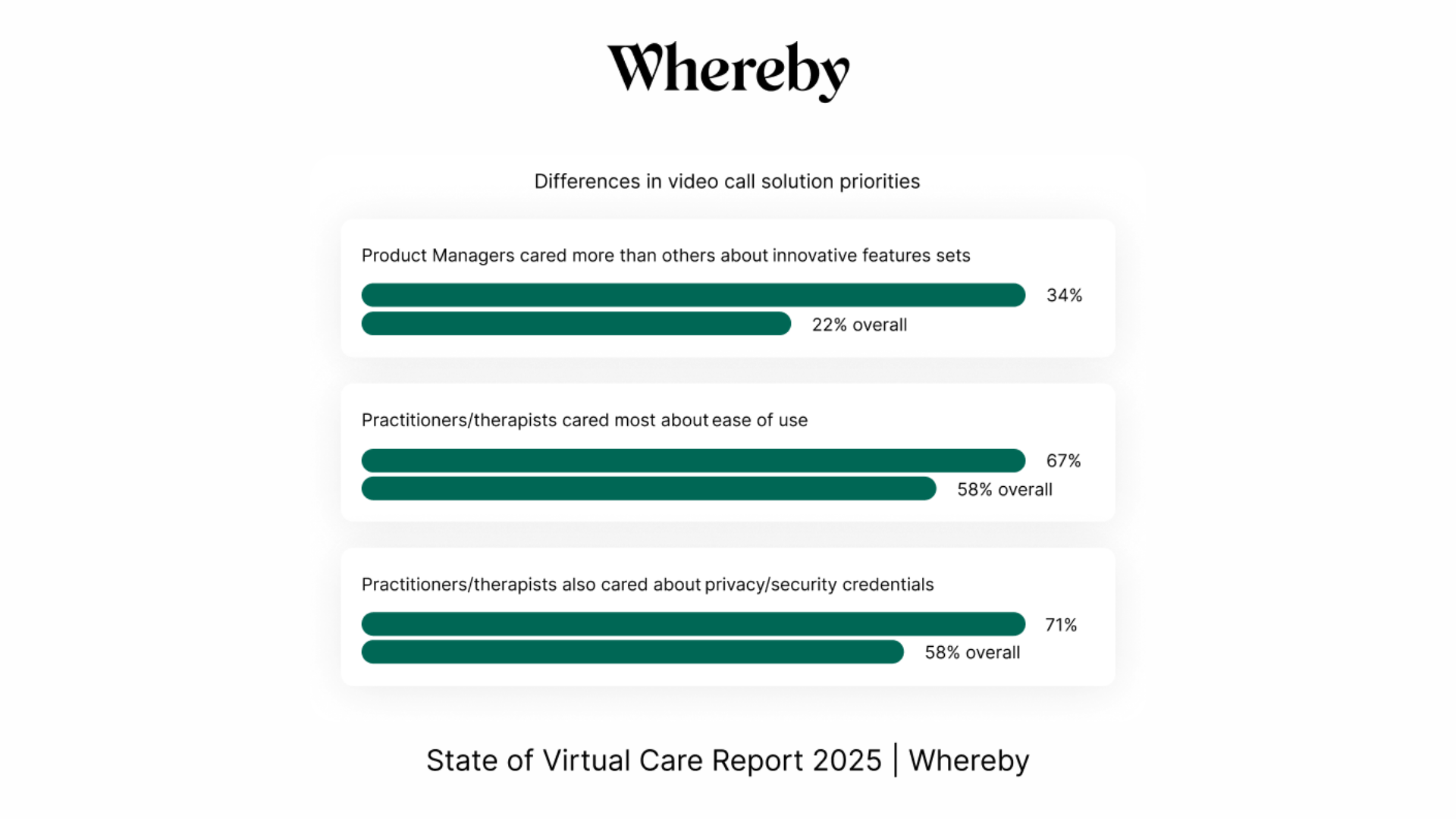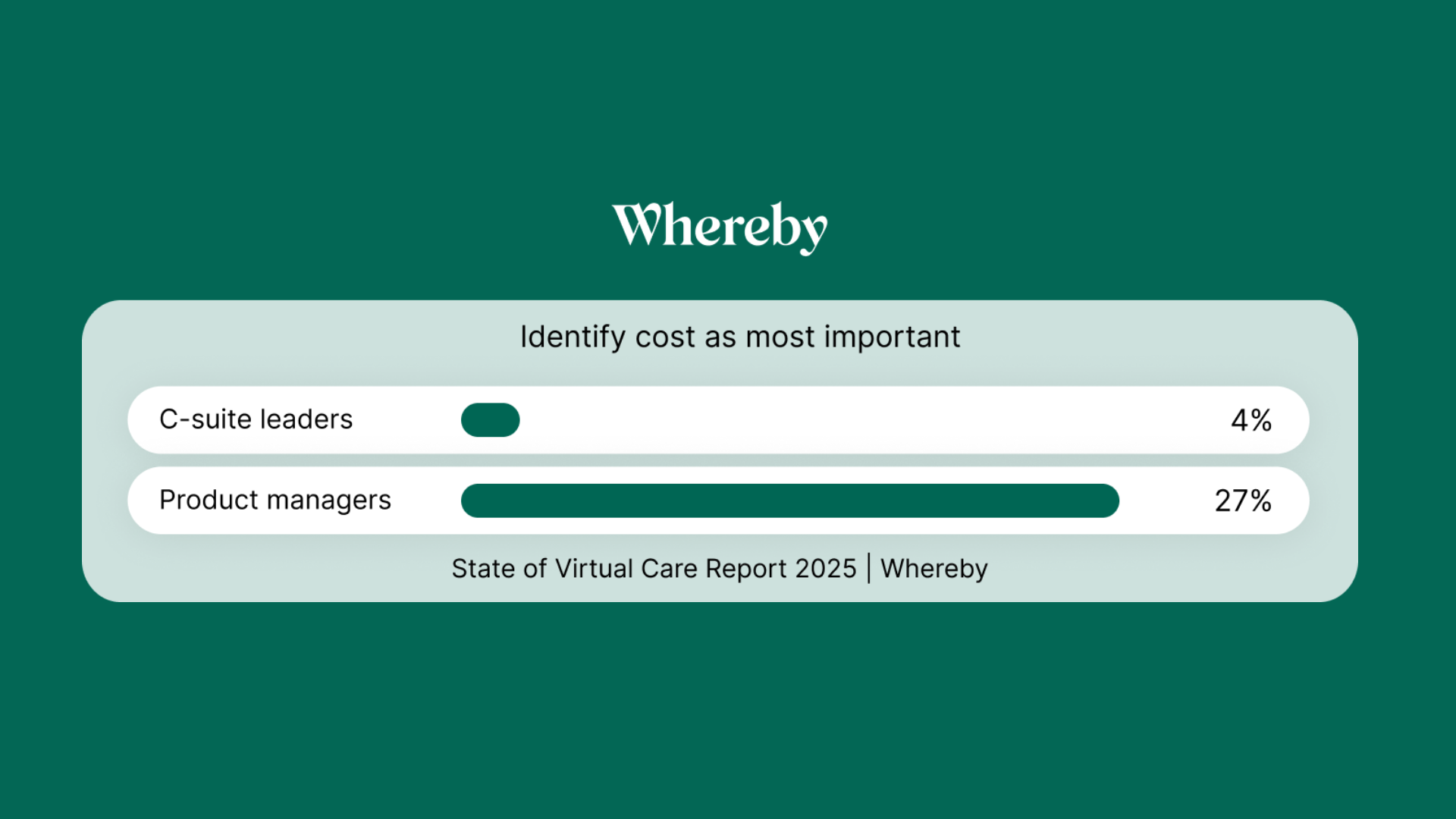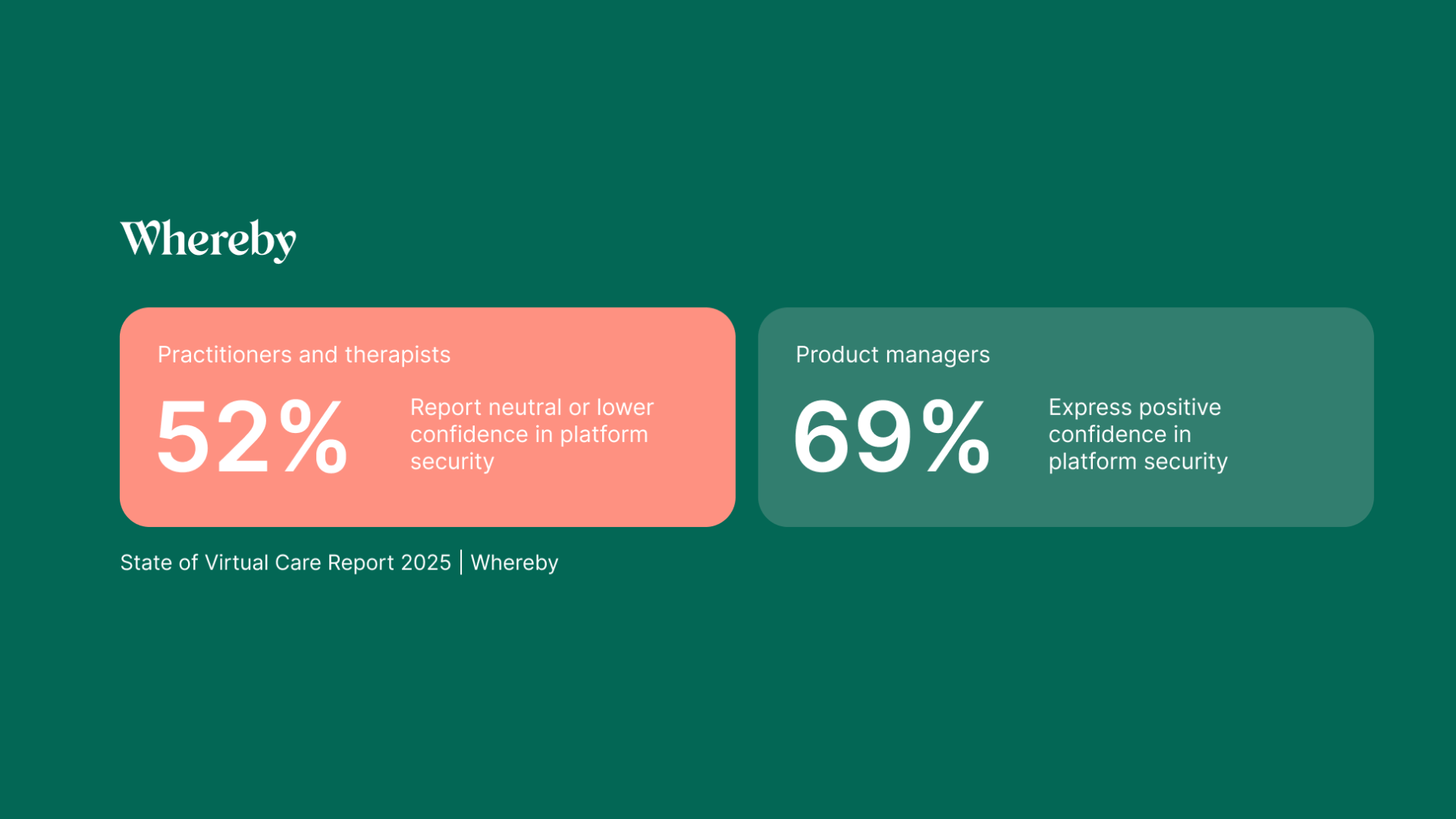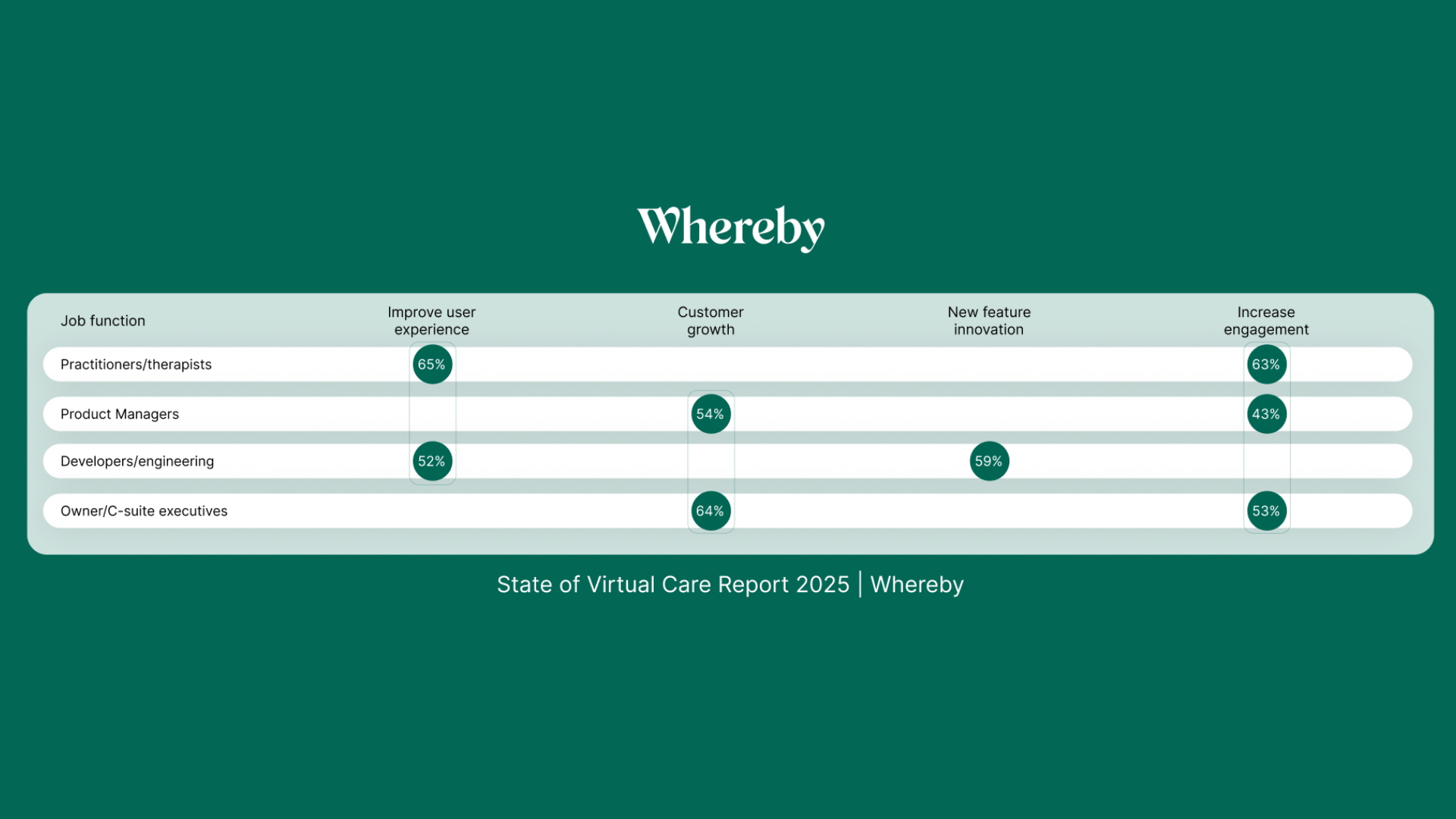Bridging the Conflicting Team Priorities in Telehealth for Better Care
Telehealth teams share one goal, but different priorities. Learn what those conflicting differences are and how leading teams are closing these gaps for better virtual care.

In telehealth, everyone agrees on the mission: creating platforms that enable safe and seamless care. But behind that shared goal, different teams often face different challenges and priorities.
When we spoke with more than 160 industry leaders for our latest report, we found that these differences aren’t necessarily a problem, but when there’s friction, even good intentions can pull projects in opposite directions.
Here’s where those gaps show up most often, and how leading organisations are closing them.
The differences in telehealth priorities by job function
From our research, the major differences between practitioners, therapists, and product teams are in what they perceive as important in telehealth.
These could be the features to prioritize, what the user experience should be, what the industry challenges are, and more. Here are a few areas where the major differences in priorities lie;
1. The most important feature in a video call solution
When you ask product managers, developers, and engineers what matters most on video calls, many will talk about the innovative features. Ask practitioners, and the answers shift towards the essentials: ease of use, privacy, and security compliance.

Neither side is wrong. Innovation does drive differentiation, while simplicity and compliance keep care safe. But the catch is that these innovative new features won’t matter if practitioners struggle to log in, or if patients worry about privacy.
The foundations of reliability, security, and ease have to come first. So innovation should build on that solid base, not compete with it.
2. How important cost is when choosing a video call provider
Cost is important to owners and C-suite leaders, with 58% saying it matters, but it is rarely their top concern since only 4% list it as their number-one priority. Product managers, however, are much more cost-focused, with 27% ranking it as their most important factor.

This suggests different pressures. Product managers may feel more directly accountable for budget constraints, while executives balance cost with bigger-picture goals like user growth and engagement.
However, without alignment, this difference can create a situation where the priority is split between protecting margins and delivering the best possible experience.
3. On whether telehealth platforms are secure
Practitioners and therapists are much less confident in telehealth platform security. More than half (52%) reported neutral or low confidence in this. On the other hand, product managers are far more optimistic, with 69% saying they feel positively about security.

This gap suggests a disconnect between the people building the technology and those using it with patients. Practitioners are on the frontlines, delivering care and building trust with patients. If they’re not confident in the platform’s safeguarding, the patients won’t as either.
So this gap matters because we see that there’s a need to convey just how secure these platforms are. We need to go beyond security being “built into telehealth”. Instead, it has to be felt and trusted by those using it every day.
4. What the different future priorities are for telehealth
Fortunately, there’s some alignment in the priorities for the future. Product managers and C-Suite executives are closely aligned on prioritizing user growth and patient/practitioner engagement. Then we have practitioners and therapists who also want to improve the user experience and boost engagement, a reflection of their day-to-day interactions with patients.
However, where the split in focus emerges is in Developers and Engineering leaders. For them, feature innovation comes first, followed by user experience.

Again, while innovation is important, this emphasis risks pulling attention towards new features like AI instead of strengthening the foundations of reliable, intuitive care experiences. Without solid alignment, teams could end up chasing these features at the expense of building trust and usability.
Tips for aligning different teams in telehealth
Understanding these differences is only the first step. The next and arguably most important step is turning those differences into strengths. Alignment doesn’t mean everyone has to think the same way. It means creating systems and communication loops where each perspective adds value. Here’s how to do this;
Start with shared metrics: Setting a unified company-wide goal like patient satisfaction, session reliability, or adoption rates helps align innovation, usability, and cost efficiency around the same outcomes.
For example, product teams can own reliability metrics, and clinicians can own satisfaction metrics, while executives can ensure both are appropriately resourced. Use a shared dashboard to ensure everyone can jointly track these goals in real-time.
Communicate security and trust, not just compliance: Practitioners want visible proof that platforms are secure. Regular updates, transparent documentation, and simple language about security protocols can help close the trust gap between those who build and those who use the technology. For example, when joining a Whereby call, we explain why we need camera and mic permissions before asking for them. Another example could be showing visible safety indicators, like Whereby’s locked room icon can help put patients and practitioners at ease.
Foster cross-functional empathy: Engineers who shadow virtual consultations can see firsthand the challenges practitioners face. Likewise, clinicians who understand how product teams balance scalability and compliance can better appreciate technical constraints. These exchanges can help build empathy and translate abstract requirements into meaningful design choices.
We also recommend including practitioner feedback in your sprint reviews or roadmap discussions so their voices are heard and shape feature priorities from the start.
Collaborate with your video vendor: Partnering with the right video call provider, like Whereby, can surface valuable insights and key metrics that help teams focus on what really matters. When there’s a direct feedback loop, teams can come together to identify areas for improvement.
Innovate on top of a solid foundation: The best telehealth products will strike a balance by continuously innovating while reinforcing reliability, simplicity, and safety. Teams that coordinate around these principles can move faster without compromising care quality or user trust. So we recommend celebrating foundational wins like uptime or load speed as much as flashy new features.
If you’d like to dig deeper into how industry leaders are shaping the future of telehealth and get more insights by role or region, check out the full report on the state of virtual care.


